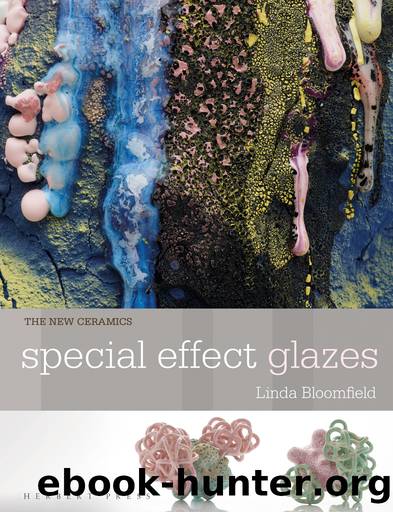New Ceramics by Linda Bloomfield

Author:Linda Bloomfield
Language: eng
Format: epub
ISBN: 9781912217892
Publisher: Bloomsbury Publishing
Published: 2020-03-15T00:00:00+00:00
Tessa Eastman, Pollinating Creatures I & II, 2016, 30 x 30 x 31cm (11¾ x 11¾ x 12¼ in.). Private Collection. Sylvain Deleu Photography.
Tessa Eastman, Sprouting Limitless Cloud, 2017, 60 x 40 x 35cm (23½ x 15¾ x 13¾in.). Private Collection. Sylvain Deleu Photography.
Joe Thompson, Old Forge Creations, thrown stoneware dish, Snowflake crackle glaze over blue slip, fired to cone 6, dia: 12cm (4¾in.). Recipe given here.
11 Crackle glazes
Crazing or crackle is technically a defect where the glaze is too small for the clay body. On cooling in the kiln, the glaze contracts more than the clay and a network of fine cracks develops. Cracks can continue to appear over weeks and months, particularly if there are sudden temperature changes such as those which occur when the pot is put in the oven or dishwasher. Crackle is often used as a decorative effect in ceramics from the Far East, but the cracks can greatly weaken the pot, causing it to crack and break more readily than a pot with an uncrazed glaze. Crazing on earthenware pots can cause them to leak, as the fired clay body remains porous and water can seep through. The cracks can also harbour dirt and bacteria, so are not ideal on functional pots, particularly in earthenware. Crackle glazes are often high in sodium and may not be chemically durable (i.e. not resistant to attack by acids in food or alkaline soap in the dishwasher). Some potters use a different glaze on the inside to avoid this problem, but this must be done carefully â a glaze with a different expansion can cause the work to crack.
Crazing occurs when the glaze has a higher thermal expansion than the clay body. If the glaze and clay body have very different rates of expansion, the glaze fit will be poor and crazing may occur. The extent of crazing will depend on the stress or mismatch between the clay and glaze. The brittle nature of glaze means it is not able to stretch, so instead it forms a network of cracks to release the stress. This can occur over time and is responsible for the pinging sound sometimes heard when pots are removed from the kiln. Crazed or crackle glazes can be achieved by adding glaze materials which have a relatively high expansion. These materials include soda feldspar, nepheline syenite and high alkaline frit. Guan (kuan) and Snowflake crackle are types of Chinese crackle glaze, applied thickly, that give a deep crackle pattern.
How to adjust crackle without changing the appearance of the glaze
We will learn about crackle by first considering the options available for eliminating crazing. While gaining an understanding of how to either reduce or increase crazing, at the same time we will learn how to make crackle glazes.
Adding silica and clay
There are several ways to correct crazing. However, changing only one material may change the appearance of the glaze, making it more glossy or matt. A reliable method is to increase both the silica (flint or quartz) and clay in the ratio 1.
Download
This site does not store any files on its server. We only index and link to content provided by other sites. Please contact the content providers to delete copyright contents if any and email us, we'll remove relevant links or contents immediately.
Kathy Andrews Collection by Kathy Andrews(11707)
The remains of the day by Kazuo Ishiguro(8787)
Paper Towns by Green John(5065)
Spare by Prince Harry The Duke of Sussex(5053)
The Body: A Guide for Occupants by Bill Bryson(4952)
Industrial Automation from Scratch: A hands-on guide to using sensors, actuators, PLCs, HMIs, and SCADA to automate industrial processes by Olushola Akande(4913)
Machine Learning at Scale with H2O by Gregory Keys | David Whiting(4106)
Be in a Treehouse by Pete Nelson(3923)
Never by Ken Follett(3762)
Harry Potter and the Goblet Of Fire by J.K. Rowling(3759)
Goodbye Paradise(3710)
Into Thin Air by Jon Krakauer(3289)
The Remains of the Day by Kazuo Ishiguro(3280)
The Cellar by Natasha Preston(3242)
The Genius of Japanese Carpentry by Azby Brown(3209)
Fairy Tale by Stephen King(3193)
120 Days of Sodom by Marquis de Sade(3161)
The Man Who Died Twice by Richard Osman(2979)
Drawing Shortcuts: Developing Quick Drawing Skills Using Today's Technology by Leggitt Jim(2975)
